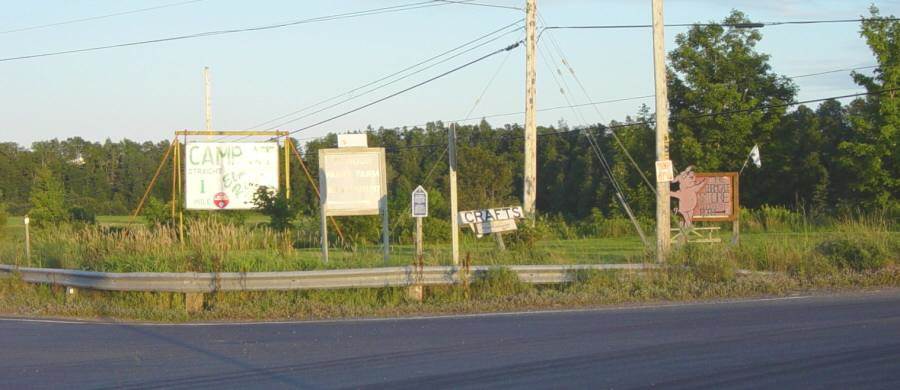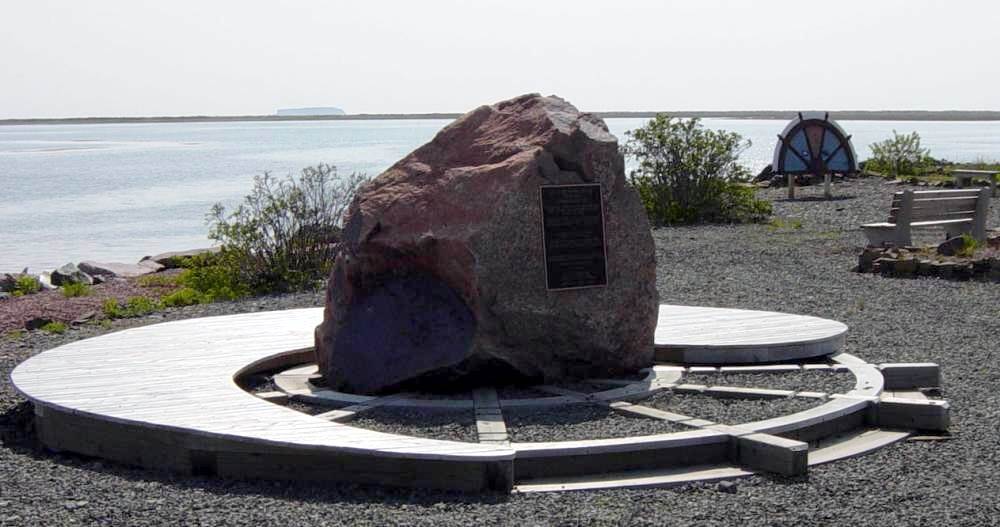
Photographs of
Commercial Cable Trans Atlantic Park
Owned by the Municipality of the District of Guysborough
Hazel Hill Guysborough County Nova Scotia
Located on the north side of Highway 16 in Hazel Hill,
adjacent to the old Commercial Cable Building
GPS location: 45°19’40″N 61°01’42″W
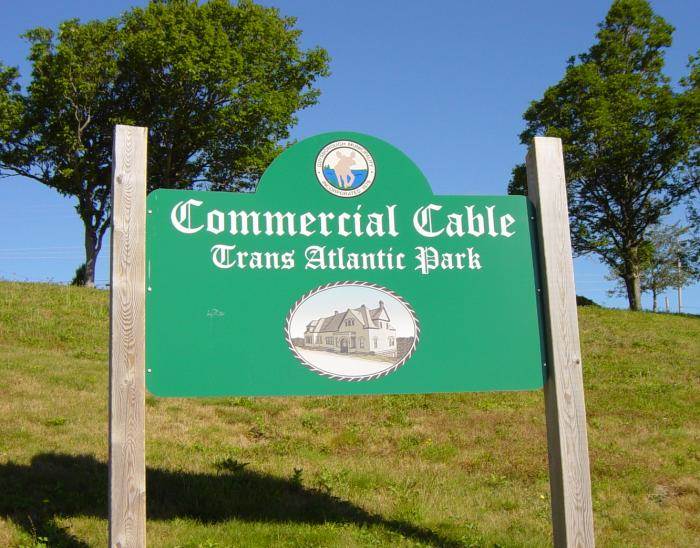
Photographed on 18 August 2005
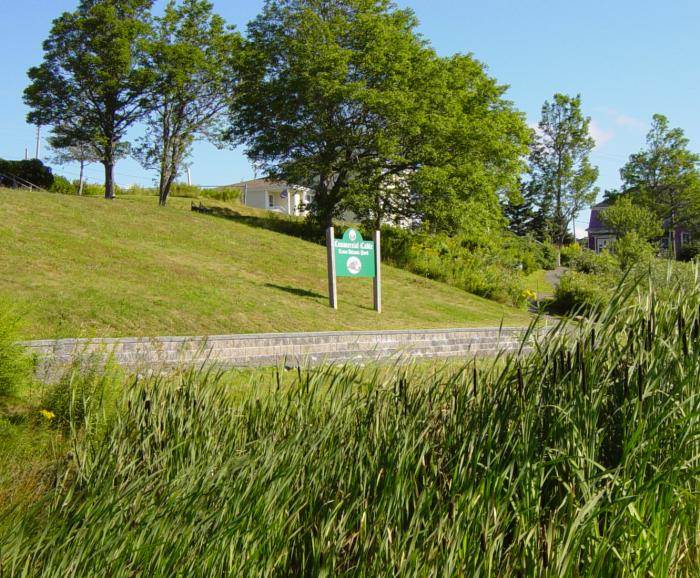
Photographed on 18 August 2005

Commercial Cable Trans Atlantic Park, municipal park at Hazel Hill.
The interpretative panels are seen at the right side of this view.
Photographed on 18 September 2003
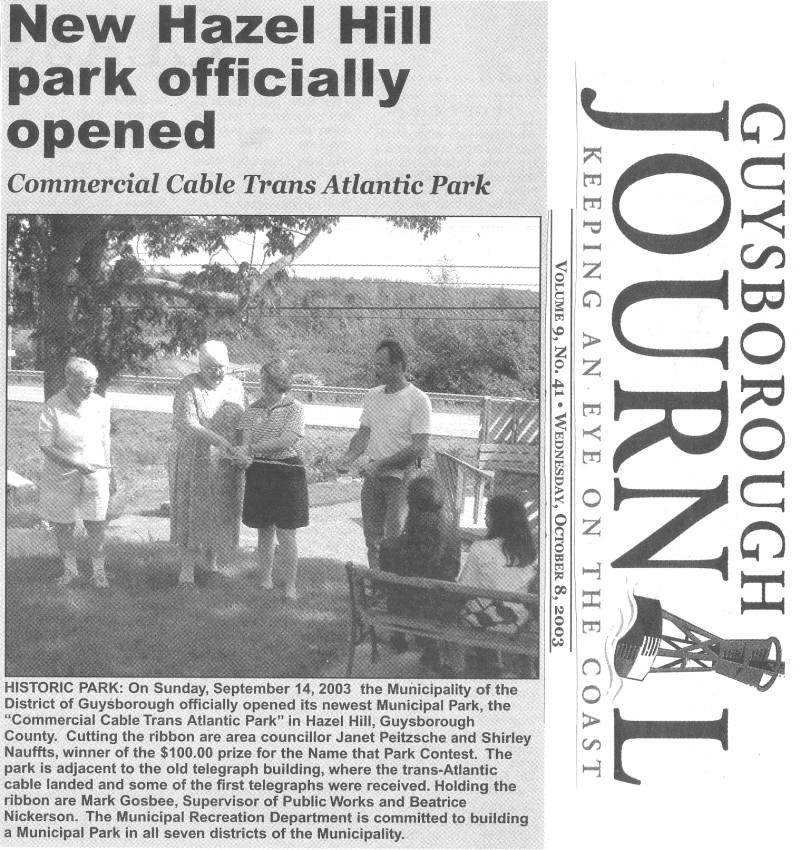
Clipping from the Guysborough Journal, 8 October 2003
In the clipping (above), …”telegraphs” were received…
should read “telegraph messages” were received,
or “telegrams” or “cablegrams” were received.

Commercial Cable Trans Atlantic Park, municipal park at Hazel Hill.
The derelict Cammercial Cable Telegraph Office
is seen beyond the park interpretative panels.
Photographed on 30 July 2005
Commercial Cable Telegraph Office

Photographed on 30 July 2005
Commercial Cable Trans Atlantic Park
West Interpretative Panel

West (left) interpretative panel
Photographed on 18 August 2005
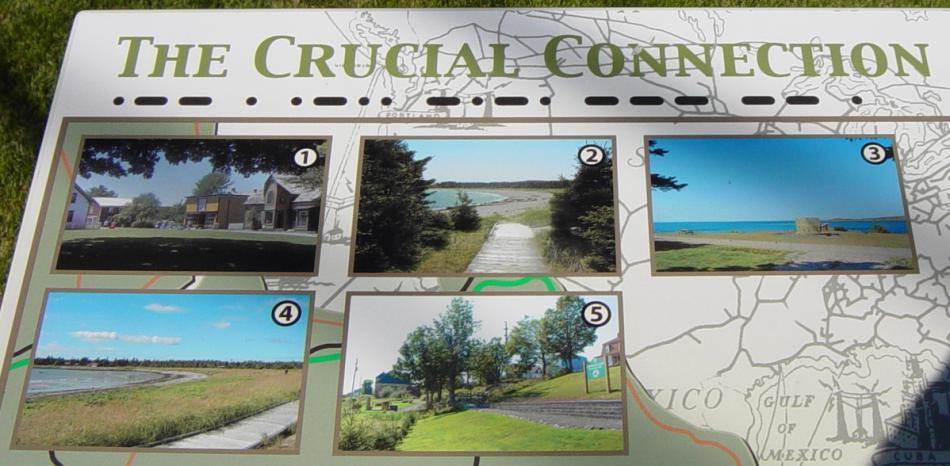
#1: Sherbrooke, #2: Tor Bay, #3: Fox Island,
#4: Little Dover, #5: Hazel Hill
Detail, west interpretative panel, Commercial Cable Trans Atlantic Park
Photographed on 18 August 2005

Detail, west interpretative panel, Commercial Cable Trans Atlantic Park
Photographed on 18 August 2005

Detail, west interpretative panel, Commercial Cable Trans Atlantic Park
Photographed on 18 August 2005
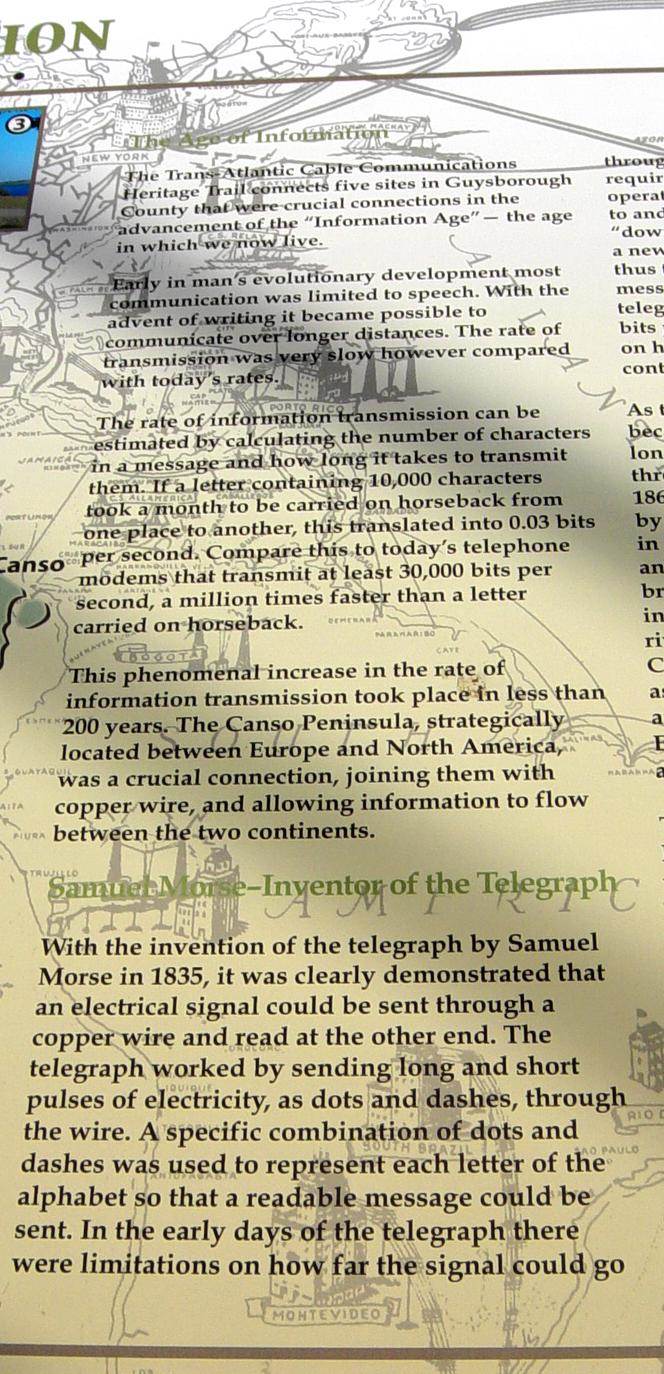
Detail, west interpretative panel, Commercial Cable Trans Atlantic Park
Photographed on 18 August 2005
Mistakes in this Interpretative Panel
This short text contains three important historical mistakes.
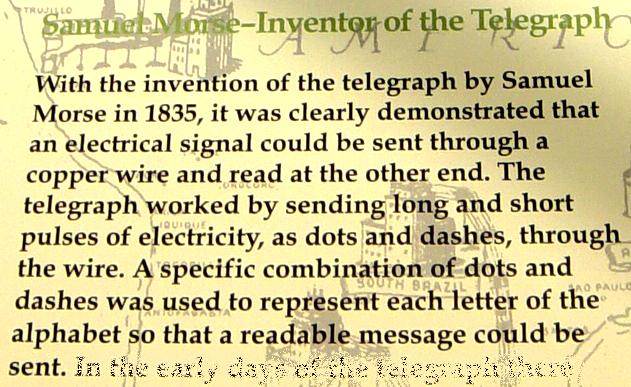
The telegraph was not invented by Samuel Morse in 1835. It was not invented by
anyone in the 1800s. Messages have been sent by telegraph for thousands of years.
Ever since the beginnings of time, people have been trying to communicate over
distances greater than the human voice could reach. Early attempts included the
use of smoke signals (by day), signal fires (at night), hoisting flags, and the moving
arms of semaphores. These message systems require the receiving end to be able
to see the sending end. Such visual systems are called “optical telegraphs”.
The ancient Greeks sent messages by optical telegraph. Four hundred years ago,
in the time of Queen Elizabeth I, England’s Royal Navy had a well-organized method
for transmitting messages from one ship to another while both were under way,
using flags, an optical telegraph system. There are numerous similar well-known
examples. These optical systems were and are genuine telegraphs by any
definition, and are included in every competent history of telegraph technology.
Similar telegraph systems exist in modern times. Every navy in the world now uses
three distinct systems of optical telegraph: flashing light, flaghoist, and semaphore.
This text is evidence of incredibly sloppy historical research. Many years before
Samuel Morse began tinkering with electricity, it was widely known that an electric
current (signal) could be sent through a wire (copper or iron or silver…) and
observed (read) at the other end. The work done in Sweden by Oersted, in
France by Ampere, and in England by Wheatstone and others, years before
Morse, is well-known. In 1830 – five years before 1835 – Joseph Henry in the
United States demonstrated the ability to send an electric signal more than a
mile and have it observed (read) at the other end. William Cooke and Charles
Wheatstone developed the first electric telegraph to go into commercial service,
which began operation in England in 1839, five years before Morse’s first
commercial telegraph line started operation in 1844. No competent
communications historian credits the invention of the electric telegraph to Morse.
The history of the electric telegraph begins in 1747, when an Englishman
named William Watson showed how to send electrostatically-generated signals
long distances through a wire, with the circuit completed through the earth.
Seven years later, in 1752, an anonymous writer published an article in the
Scots Magazine, Edinburgh, Scotland, showing how to send messages
with an array of twenty-six such wires (one for each letter of the alphabet).
Various forms of this multiple-wire electric telegraph system were built in
Switzerland in 1774, in France in 1787, and in Spain in 1798. Between 1800
and Morse’s work, many workable electric telegraph systems were developed.
Inventing the Telegraph by John H. Lienhard
http://www.uh.edu/engines/epi1393.htm
Invention of the Telegraph by J. B. Calvert
http://www.du.edu/~jcalvert/tel/morse/morse.htm#C
The panel text mentions Morse’s telegraph code, but does not adequately
convey its significance in the history of telecommunications or the fact that
this is the reason Samuel Morse is remembered today.

Detail, west interpretative panel, Commercial Cable Trans Atlantic Park
Photographed on 18 August 2005
Commercial Cable Trans Atlantic Park
Center Interpretative Panel
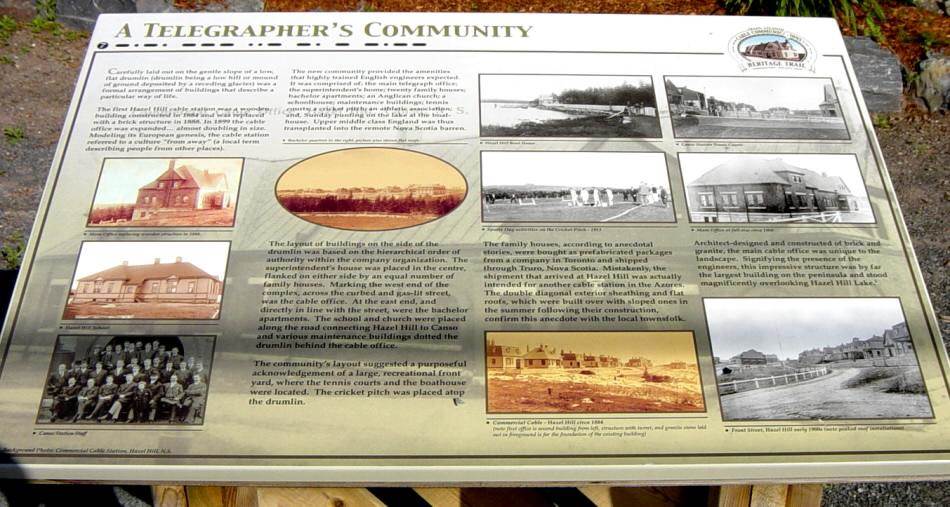
Center interpretative panel
Photographed on 18 August 2005
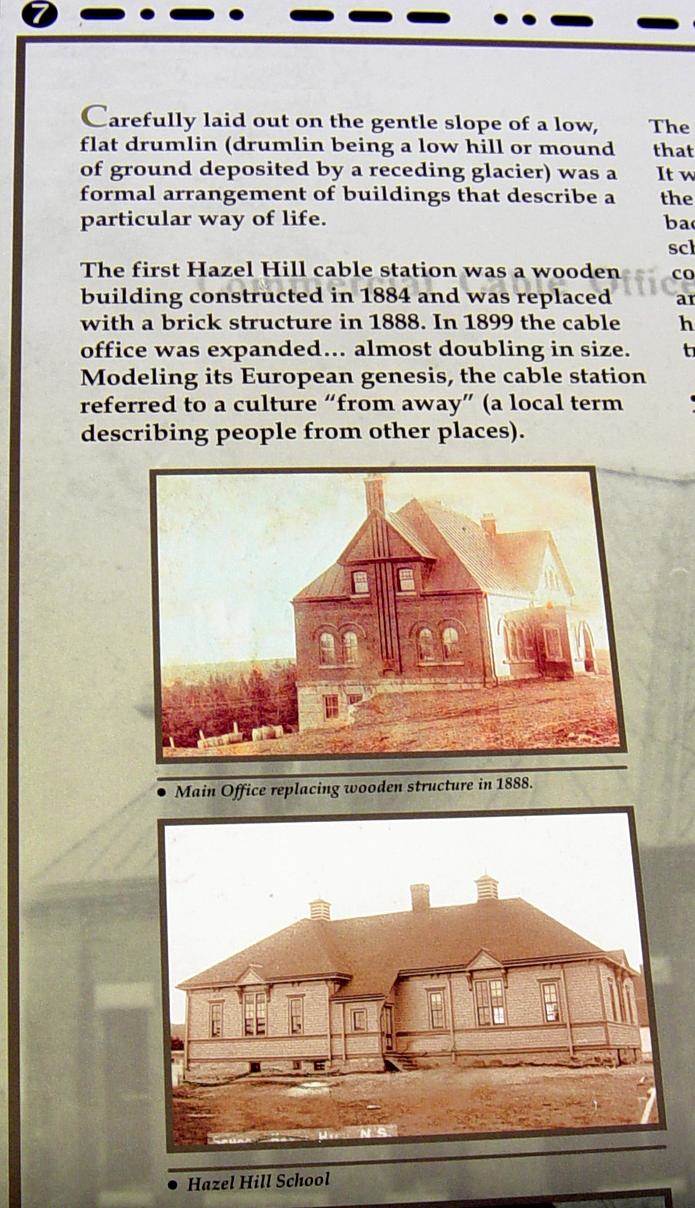
Detail, center interpretative panel
Photographed on 18 August 2005
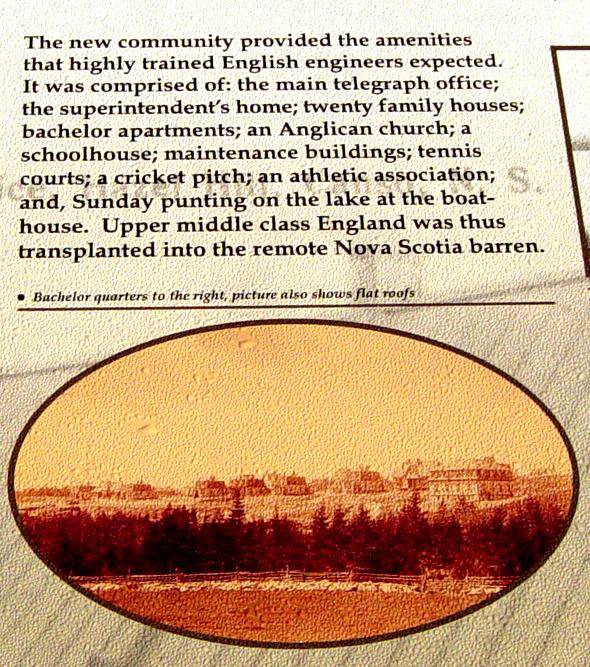
Detail, center interpretative panel
Photographed on 30 July 2005

Detail, center interpretative panel
Photographed on 18 August 2005

In the photograph (next above) the flat roofs on the houses are clearly visible.
Detail, center interpretative panel
Photographed on 18 August 2005
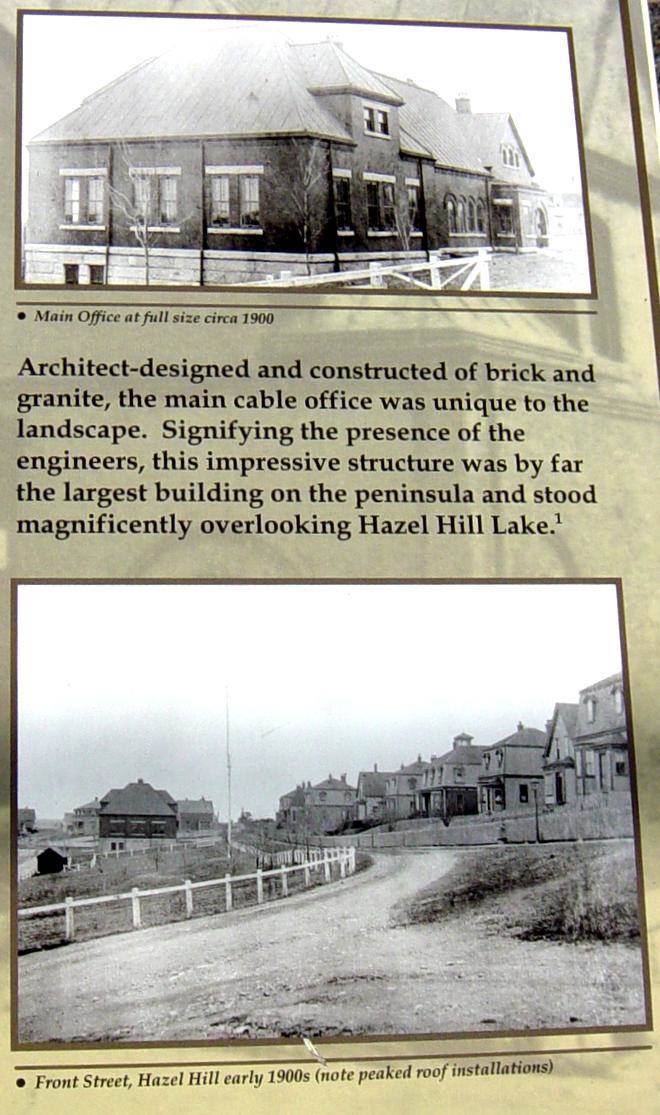
Detail, center interpretative panel
Photographed on 18 August 2005
Commercial Cable Trans Atlantic Park
East Interpretative Panel
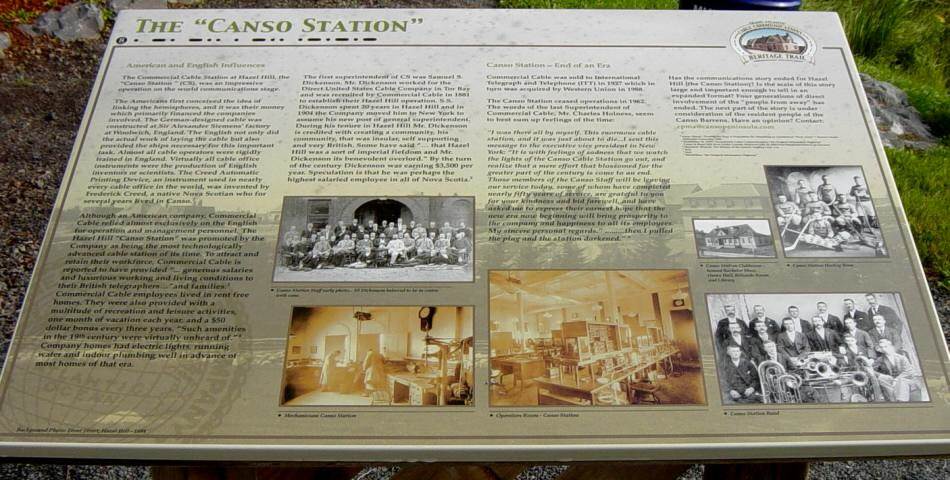
East (right) interpretative panel
Photographed on 16 August 2005

Detail, east interpretative panel
Photographed on 16 August 2005
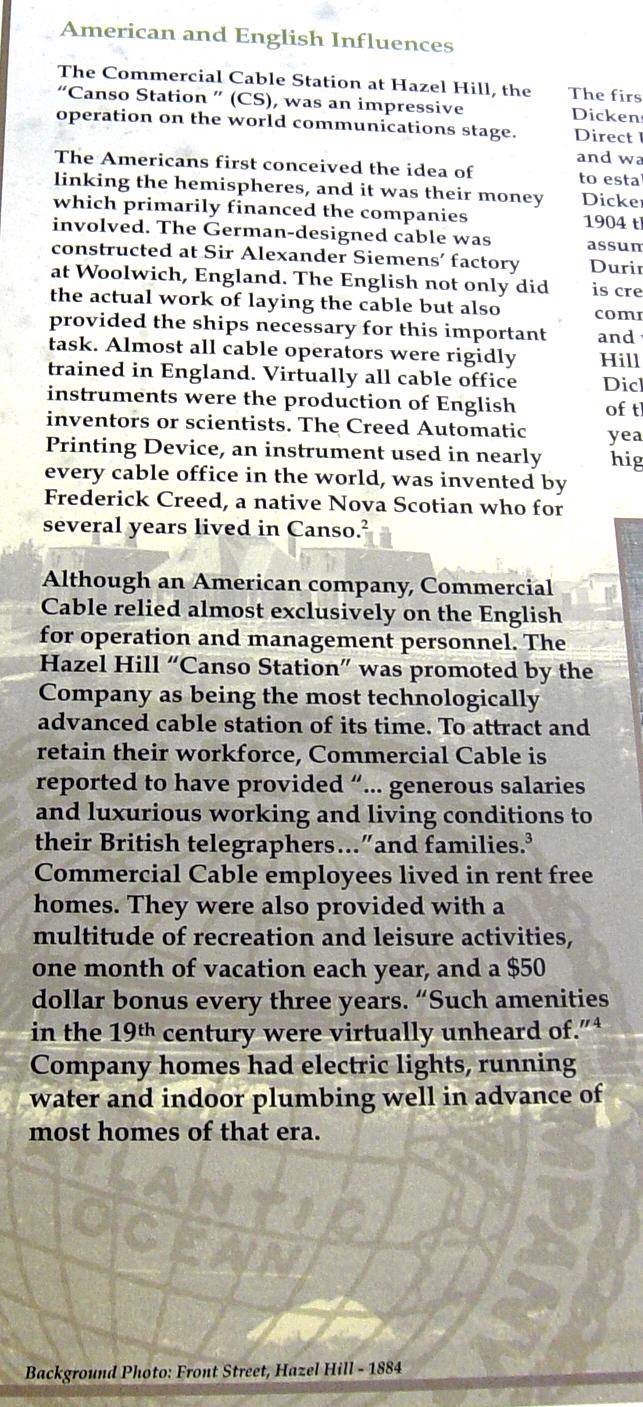
Detail, east interpretative panel
Photographed on 16 August 2005
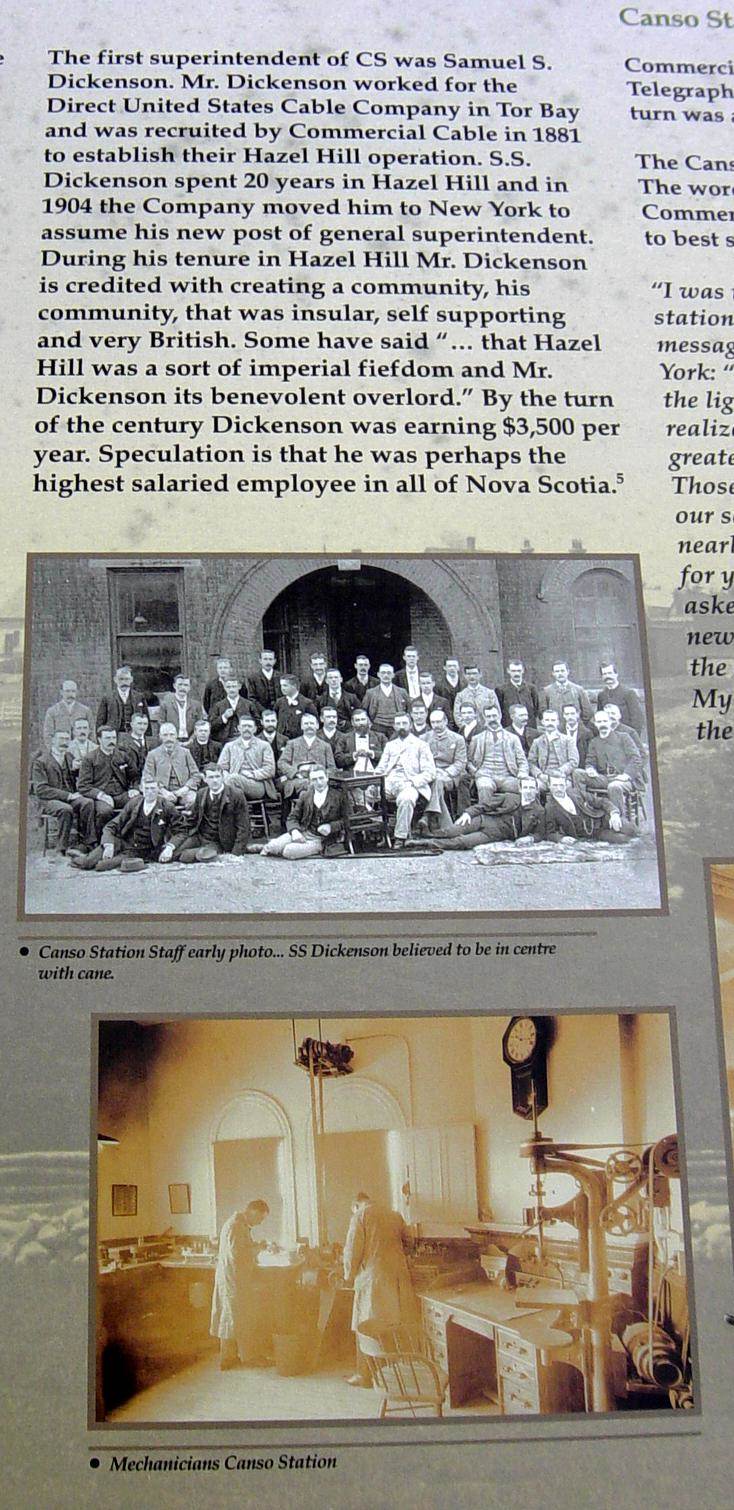
The job then known as a “mechanician” is now called a “technician”.
“Technician”: A person whose occupation involves training in a specific
technical process; an expert in troubleshooting system malfunctions.
A person skilled in the methods and techniques of a specific technology.
Along with a thorough knowledge of test equipment and how to use it
to diagnose problems, the technician is also familiar with
how to repair or replace faulty components.
Photographed on 16 August 2005
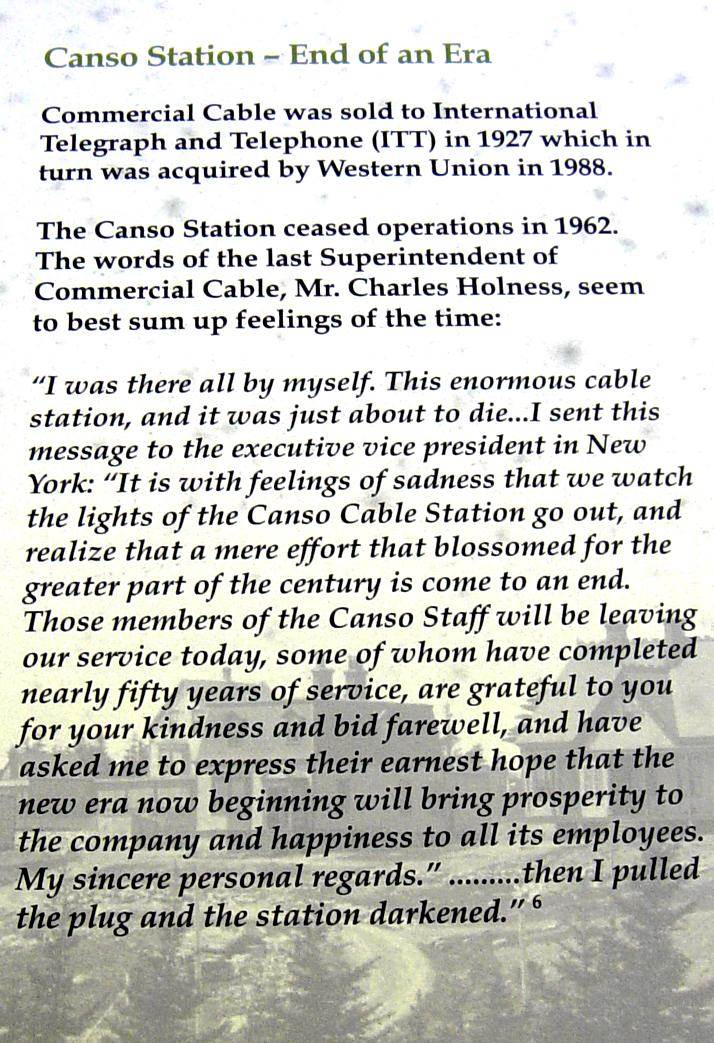
Detail, east interpretative panel
Photographed on 16 August 2005
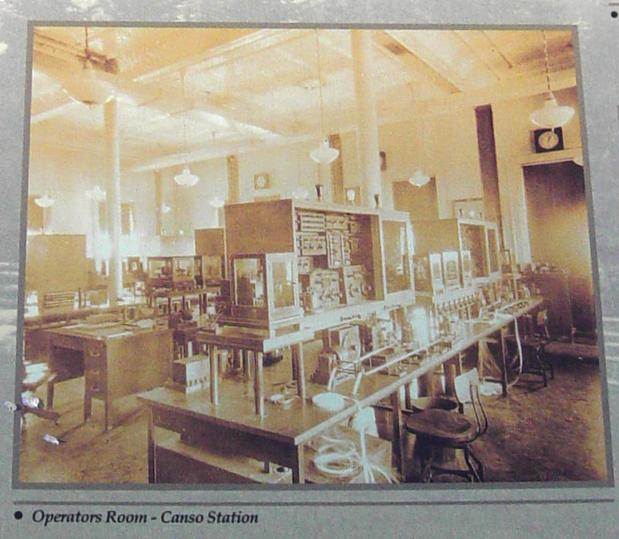
Detail, east interpretative panel
Photographed on 30 July 2005

Detail, east interpretative panel
Photographed on 16 August 2005

Detail, east interpretative panel
Photographed on 16 August 2005
Search for mystery pioneer Scot
The Scotsman (newspaper), 1 February 2003
250 years ago today (in February 1753) a Scottish inventor published a detailed
description of a then-unknown machine that used electricity carried by metallic wires,
to “convey intelligence” from one place to another without carrying a written message
to the destination. This is the earliest known description of the telecommunications
system we now call the electric telegraph. The problem is, the scientist’s identity has
never been established. The anonymous article described for the first time how
electricity could be applied to a wire to create a communication device, using 26
parallel lengths of wire, one for each letter of the alphabet. The article includes
the phrases “signalling at a distance by the use of electricity”, and “an expeditious
method of conveying intelligence”. Twenty-five decades later, no clearer description
of the electric telegraph can be formulated.
http://thescotsman.scotsman.com/index.cfm?id=126552003
Early Wired Telegraphy 1774-1798
http://people.deas.harvard.edu/~jones/cscie129/images/history/lesage.html
A Short History of Telegraphy: Part 1, Beginnings by Alan G. Hobbs and Sam Hallas
http://www.samhallas.co.uk/telhist1/telehist.htm
Joseph Henry: Inventor of the Telegraph? By David Hochfelder
Smithsonian Institutional History Division
http://www.si.edu/archives/ihd/jhp/joseph20.htm
Telegraph History: Western Union Telegraph Company Records 1820-1995
http://invention.smithsonian.org/resources/fa_wu_index.aspx
Morse Code by Wikipedia
http://en.wikipedia.org/wiki/Morse_code
History of Morse Code
http://encyclopedia.laborlawtalk.com/Morse_code
International Morse Code by the Canadian Navy
http://www.navy.forces.gc.ca/mspa_youth/youth_sc_morse1_e.asp
The Science of Morse Code Industry Canada
http://epe.lac-bac.gc.ca/100/205/301/ic/cdc/cable/scimorse.htm
International Morse Code
http://ww2.isys.ca/lberta/mrsecode.html
Telegraphy by Wikipedia
http://en.wikipedia.org/wiki/Telegraphy
Telegraphic Codes and Message Practice, 1870-1945
website by John McVey
http://www.jmcvey.net/cable/ex/index.htm
Nova Scotia’s Telegraphs, Landlines And Cables by D.G. Whidden, 1938
https://ns1763.ca/tele/whidden2.html
Commercial Cable Company
History of the Commercial Cable Company
http://www.cial.org.uk/
The White Family Archive
George White, the last General Manager of Commercial Cable Company
in the UK, had his 100th birthday in November 2004.
http://www.cial.org.uk/white/index.htm
History of the Commercial Cable Company
http://alts.net/ns1625/telegraph02.html#commcabstart
Maps showing Transatlantic Telegraph Cable Routes
These are excellent maps but the online version does not work
in many browsers, such as Firefox, Safari and Opera.
They do work in IE5. Netscape maybe.
http://www.cial.org.uk/wsm/maps.htm
Pacific Postal Telegraph Cable Company
The history of the Pacific Postal Telegraph Cable Company is simple.
When Mr. John W. Mackay, the famous Bonanza millionaire,
and Mr. James Gordon Bennett, of the New York Herald, associated
themselves together for the purpose of building the “Commercial” cable
across the Atlantic, they readily recognized the fact that the
“Field” cable was operated in conjunction with the Western Union lines,
and that a rival cable must be fed by friendly inland lines…
— San Francisco News Letter and California Advertiser
19 February 1887
http://www.sfmuseum.org/hist11/pacificpostal.html
Commercial Cable Rehabilitation Society
incorporated 22 March 2005 in Nova Scotia
http://www.ccrsociety.ca/


